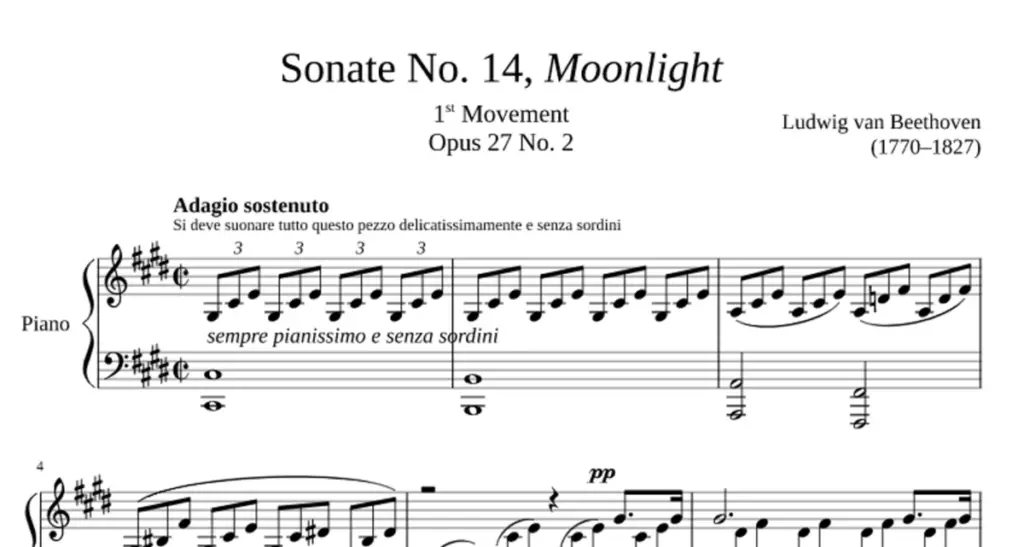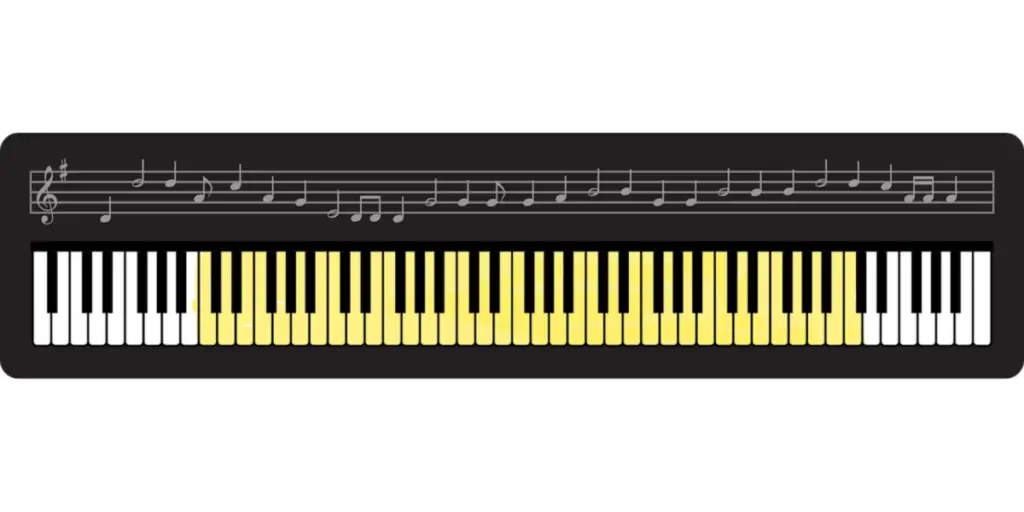This post contains affiliate links.
Moonlight Sonata is one of Beethoven’s most well-known compositions. The Sonata consists of 3 movements and can take up to 18 minutes to finish. Now you want to learn it but aren’t sure which movement will fit on a 61-keys keyboard.
The first and second movements of Moonlight Sonata can be played on 61 keys if you omit some of the lower notes on the left hand. However, the third movement can’t be played on 61 keys because there are too many notes out of range and you need weighted keys to play the movement properly.

In this article, I’ll go over how to play the first and second movements of Moonlight Sonata on a 61-key keyboard, and list out the reasons why the third movement can’t be played on 61 keys.
Finally, I’ll list out some composers whose pieces fit on a 61-keys keyboard so you can play classical music on an electric keyboard.
How to play the first and second movements of Moonlight Sonata on 61 keys
Before going into which notes to omit to be able to play the first and second movements on 61 keys, you need to know what kind of range your 61-key keyboard has and what does that range looks like on music sheets:


Now looking through the music sheets for the first and second movements, all the notes in the treble clef are within the range of a 61-keys keyboard.
However, some of the notes in the bass clef are out of range. Ideally, you want to play every single note since that is how the piece was composed. But here you have a choice to either make compromises or wait until you get a full-fledged 88 keys piano before learning this piece.
All the notes that are out of range in both movements are the lower notes of octaves played on the left hand. Thus, the solution is to omit those lower notes and play only the notes that fit on the keyboard
Or, since you’re playing octaves on the left hand, you can try playing them one octave higher. For example, takes this excerpt from the first movement:

Notice the octave F you need to play on your left hand. the lower F1 isn’t present on a 61-keys keyboard, so you can try replacing F1 by playing the higher F3 and see if you like the sound of it.
Since the first and second movements don’t have a lot of notes out of range, and the notes that are out of range are a part of an octave so you can get away with omitting the lower notes of those octaves.
Reasons the third movement of Moonlight Sonata can’t be played on 61 keys
There are a lot more octaves and notes that are out of range for the third movement, where if you omit them like in the first and second movement, it’ll affect the sound.
Furthermore, the third movement is known to be very hard and is one of the options to choose from to perform in the RCM level 10 exam. For those that don’t know, the RCM exam is a prestigious and widely-recognized music program here in North America.
Level 10 is the highest level of performance before the ARCT exam, which is the equivalence of a bachelor’s degree. To get to level 10, a complete beginner would need at least 10 years if they aren’t skipping any levels.
What this means is that you can’t properly learn the third movement using the cheap, unweighted keys of an electric keyboard. The third movement requires agility, dynamics, voicing and phrasing that can only be learnt using weighted keys from acoustic or digital pianos.
Also, because the third movement is so hard, you often need guidance from a piano teacher to learn the movement, and to spot and fix any mistake you make before it becomes a bad habit or worse, can injure you.
Furthermore, you can’t do the movement justice and gives it the respect it deserves playing on an electric keyboard.
However, if you really want to play the third movement on 61 keys, prepare yourself by learning easier pieces first, then learn and play the parts from the movement that fits on 61 keys.
Classical composers that can be played on 61 keys
If you’re looking for other Beethoven pieces to play on 61 keys, only his early works will fit perfectly on 61 keys (5 octaves) since later in his life, the piano started having more than 5 octaves and so Beethoven composed pieces using more than 5 octaves.
For example, Beethoven’s most popular piece Fur Elise, composed in 1810, doesn’t fit on 61 keys since there are some parts that are out of range.
With that said, by simply removing some of the higher notes from the piece, you’ll be able to play the piece on 61 keys while the sound remains more or less the same as the original. I wrote about how to play Fur Elise on 61 keys in Can Fur Elise be Played on a 61-Keys Keyboard?
Other composers whose pieces fit on 61 keys are from the Baroque era (1600 – 1750). So pieces from Bach, Hadyn or Mozart will fit on 61 keys.
This is because back then, the keyboard only has 5 octaves so all composers had to compose pieces with that limitation in mind.
However, you won’t be able to play most pieces from composers like Chopin, Liszt or Debussy on a 61 keys keyboard because, by the time they were alive (19th century onwards), the modern piano with 7 octaves or more was already invented, and these composers usually used the whole 88 keys range when composing piano pieces.
I wrote articles listing some classical pieces that you can play on a 61-keys keyboard:

